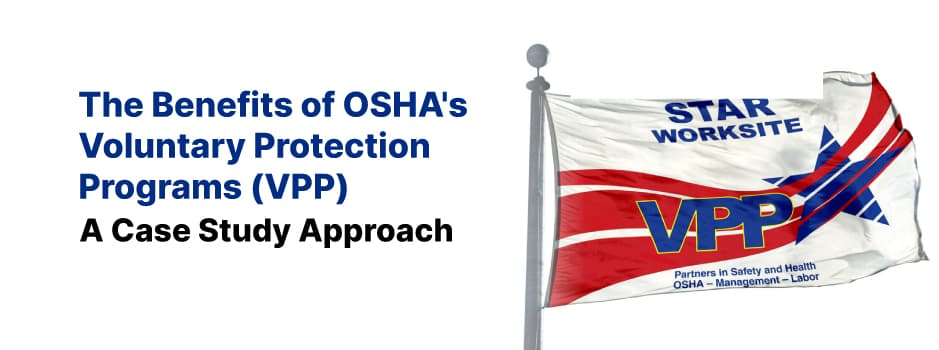Introduction
The Occupational Safety and Health Administration's (OSHA) Voluntary Protection Programs (VPP) recognize employers and workers who have implemented exemplary safety and health management systems, fostering a culture of continuous improvement in workplace safety. By participating in VPP, employers can benefit from reduced injury rates, improved employee morale, and potential cost savings. In this blog, we will explore the benefits of OSHA's VPP through a case study approach, examining real-life examples of companies that have successfully implemented VPP and reaped its rewards.
Case Study: ABC Manufacturing
ABC Manufacturing, a mid-sized company specializing in producing automotive parts, recognized the need to improve their workplace safety culture and reduce injury rates. They decided to pursue VPP certification as a means of achieving these goals.
By implementing a comprehensive safety and health management system and engaging employees in the process, ABC Manufacturing was able to achieve VPP Star status within two years. As a result of their efforts, the company experienced a 50% reduction in recordable injury rates and a 30% reduction in workers' compensation costs. Additionally, employee morale and engagement improved, as workers felt more involved in maintaining a safe work environment.
Case Study: XYZ Chemical Plant
XYZ Chemical Plant, a large facility handling hazardous materials, sought to enhance their safety performance and demonstrate their commitment to employee safety by participating in OSHA's VPP. To achieve this, they focused on improving hazard identification and control, employee training, and emergency preparedness.
After implementing these changes and obtaining VPP Star status, XYZ Chemical Plant saw a 60% reduction in recordable injuries and a 40% reduction in lost workdays due to injury. The company also experienced fewer regulatory citations and improved relationships with local emergency response agencies.
Case Study: LMN Construction Company
LMN Construction Company, a rapidly growing commercial construction firm, recognized the importance of prioritizing workplace safety as they expanded their operations. They decided to pursue VPP certification as a means of fostering a proactive safety culture and ensuring their employees had the necessary tools and training to work safely.
Through their participation in VPP, LMN Construction Company was able to significantly improve their safety performance, achieving a 70% reduction in recordable injuries and a 65% reduction in lost workdays. In addition, the company was able to secure more contracts due to their reputation for safety excellence, resulting in increased revenue and business growth.
The Benefits of OSHA's Voluntary Protection Programs
These case studies demonstrate the wide range of benefits that can be achieved through participation in OSHA's VPP, including:
- Reduced injury rates: Companies that participate in VPP typically experience lower recordable injury rates, resulting in a safer work environment and fewer lost workdays due to injury.
- Improved employee morale and engagement: Employees at VPP-certified companies often report higher levels of job satisfaction and engagement, as they feel empowered to contribute to workplace safety and recognize their employer's commitment to their well-being.
- Cost savings: Reduced injury rates can lead to significant cost savings in workers' compensation premiums, medical expenses, and regulatory fines.
- Enhanced reputation and business opportunities: Companies with VPP certification often enjoy an improved reputation for safety excellence, which can help attract new customers and secure more contracts.
- Regulatory compliance: Participation in VPP demonstrates a company's commitment to regulatory compliance and can result in fewer OSHA inspections and citations.
Steps to Achieving VPP Certification
For companies interested in pursuing VPP certification, the following steps can help guide the process:
- Perform a gap analysis: Evaluate your current safety and health management system against the VPP requirements to identify areas for improvement.
- Develop an action plan: Based on the gap analysis results, create a detailed action plan for implementing the necessary changes to meet VPP requirements. This may include updating policies, enhancing employee training programs, or improving hazard identification and control processes.
- Engage employees: Involve employees in the VPP process, from planning to implementation, to foster a culture of safety ownership and commitment throughout the organization. Encourage open communication about safety concerns and ideas for improvement.
- Implement changes and monitor progress: Execute the action plan and regularly monitor progress towards meeting VPP requirements. Adjust the plan as needed to ensure continuous improvement in safety performance.
- Apply for VPP certification: Once the necessary improvements have been made, submit an application for VPP certification to OSHA. Be prepared for an onsite evaluation by OSHA representatives to verify compliance with VPP requirements.
- Maintain certification: After achieving VPP certification, continue to prioritize safety and health management, regularly review and update your safety programs, and engage employees in maintaining a culture of safety excellence.
Conclusion
OSHA's Voluntary Protection Programs offer employers an opportunity to go beyond mere regulatory compliance and strive for safety excellence. As demonstrated by the case studies presented in this blog, companies that invest in VPP certification can achieve significant benefits, including reduced injury rates, improved employee morale, and cost savings. By following the steps outlined above and committing to a culture of continuous improvement in workplace safety, employers can enjoy the many advantages of VPP certification and create a safer, healthier work environment for their employees.

